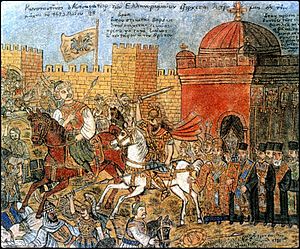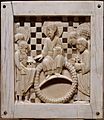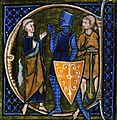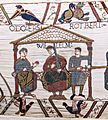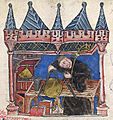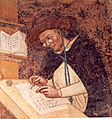Middle Ages facts for kids

The Middle Ages were a period of about a thousand years in European history. They started around the year 476 CE when the Western Roman Empire ended, and continued until around the time Christopher Columbus arrived in the New World in 1492. The 'Middle Ages' are called this because it is the time between the fall of Imperial Rome and the beginning of the Early modern Europe. This period of time is also known as the Medieval Age, the Dark Ages (due to the lost technology of the Roman empire), or the Age of Faith (because of the rise of Christianity and Islam). When used narrowly, the term "Dark Ages" refer only to very early period, from 476 to 800 CE (when Charlemagne became Holy Roman Emperor). Because few could write, less is known about the Dark Ages than about earlier times.
The fall of the Roman Empire, and the invasions of barbarian tribes, devastated European towns and cities and their inhabitants. The Dark Ages are given this name because Europe was in disarray in comparison to the orderliness of classical antiquity and life was short and poor. Much of the knowledge that the Romans used (science, technology, medicine, and literature) was lost. The Dark Ages period was marked by mass migrations, wars and plagues. This lasted some 300 years until the development of feudalism partly diminished the continuous violence. Emperor Charlemagne was crowned in 800 CE, and he promoted order, education and civilization. Europe began to slowly regain what was lost during those centuries. The Late Middle Age was a tough period with Plague and wars that killed millions of people in Europe and Asia.
During the Middle Ages, Europe changed as the remains of the great Western Roman Empire slowly became independent, unified nation states such as England,Scotland, France (Which evolved from the realm of the Franks), Hungary, Spain, Portugal, Poland, Lithuania, Denmark and Norway.
Contents
Byzantium: The other side of Rome
Meanwhile the remains of Eastern Rome had become the Byzantine Empire, which was started by Roman emperor Constantine in 330, and likewise had a capital city named Constantinople. The Byzantine empire controlled Asia Minor, Southern Spain, Northern Africa and sometimes southern Italy but its lands were slowly eaten away by enemies like the Turks and the Franks. As a walled city on a peninsula the city of Constantinople was extremely difficult to attack. The Byzantines were eventually destroyed by the Ottoman Turks, who seized Constantinople in 1453. They called the city by its present day name, Istanbul. This event is sometimes called the end of the Middle Age.
Islam and its golden age
Islam was founded in the early 7th century by the prophet Muhammad. Muslims believe that the Qur'an is God's ultimate revelation to mankind. Islam spread quickly through warfare and along the major trade routes of the old world, finding appeal with traders and travellers. The Islamic religion soon split; between the Sunni Muslims and the Shi'a. The Sunni religion is the majority (roughly 85% of Muslims belong to this sect), Most Shi'a live in modern day Iran and Iraq. The Sunni-Shi'a split has been compared to the Catholic-Eastern Orthodox split of the Christian church much later in 1054.
Muslims quickly conquered the Christian countries of Iraq, Syria, Egypt, North Africa and Spain. The Christians were able to keep France and other European countries. Later Muslims took other countries such as Persia and India where they built the Mughal Empire. The Muslim Ottoman Empire eventually conquered parts of eastern Europe. The Muslims took hold of vast areas of land making them a superpower of the Middle Ages.
During the Early Middle Ages, Muslims achieved what is remembered as a golden age of knowledge. During these times of strife in Europe, Muslim caliphs gathered the ancient texts of the great empires (Rome, Greece, Egypt) and attempted to re-integrate that knowledge. During this time a Persian Muslim helped develop progress in algebra. The golden age of Islam ended with the Ottoman invasions in the 11th century.
Asian Trade and the Bubonic Plague
During the Middle Ages trade between countries became much more common. It was mostly through the Middle Eastern / Asian trade route known as the Silk Road. Arabs served as the middle men in international trade. Trade in this time was based on how valuable the item was. The items that had higher value, and low weight, travelled the farthest (gold, silk, etc...), and items that were heavier and worth less would travel mostly short distances. Food, for example, would mostly travel only within a few villages.
During the high Middle Ages, wealth began to return and consumers began to demand luxuries again. Silk, porcelain, spices, incense, gold and gems, all travelled thousands of miles across deserts, mountains and plains. Glass was in turn imported from Europe to East.
Trade was greatly interrupted several times during the Crusades (1094-1291) due to the aggression between Muslims and Europeans, and because of Mongolian Invasions, and later because of the Black Plague. It is thought that the Mongols brought the Plague with them from Asia, and devastated the world population from 1348-1351. Almost a third of the world's population was killed by the plague at this time, although the Americas were not touched by the disease at all.
Buddhism in the Middle Ages
Buddhism is a non-theistic religion (in other words, Buddhists don't believe in a god) that is based on philosophy. It began in India but is almost entirely gone from that area now. Muslim invaders of the Mughal dynasty drove out this system of beliefs, more or less forcing Buddhism to flee East (where it eventually took strong roots in China).
The Mongolian Empire and Chinese Exploration
During the Middle Ages the Mongols created the world's largest empire, controlling much of Asia, Middle East, and far eastern Europe. Mongolia was so large and powerful that its strength lead to the Pax Mongolica, similar to the Roman Pax Romana (pax is Latin for peace). In other words, the Mongol Empire created a period of time that saw no war; only a great deal of international trade and diplomacy along the Silk Road.
Mongol leader Genghis Khan built an empire that was so large, it collapsed under its own size (much like Alexander the Great's did) around the time of the Khan's death in 1227. The former Mongol empire was split four ways, leaving the Chinese to become the dominant power in the Far East once again. Later, the Chinese took control of northern China again under the Yuan Dynasty.
Around 1405, A Chinese admiral named Zheng He went to explore the world. His fleet of 300 'treasure ships' explored great areas of the Eastern world, and were many times larger than anything the Europeans had built. (A Zheng He Treasure ship was wider than Columbus' ship 'Santa Maria' was long). Unfortunately for Zheng, his voyages were ended before he had a chance to discover the Americas.
Late Middle Ages
The Late Middle Ages were the last two centuries of the Middle Ages, from 1300 to 1492. During this period the gun changed war and aristocracy and feudalism became less important. States founded standing armies. Before, armies were only formed when there was a war. States only made their laws, money and identity the same in the entire country. Technology, economy and science developed. Cities were founded and existing cities grew larger and richer. France and England fought the Hundred Years' War. The Grand Duchy of Moscow regained its independence from the Mongols just like the Chinese, and under the name "Russia" became the most important state in Eastern Europe.
In the 15th century, the Ottoman Turks conquered the Byzantine Empire. That event cut off the Silk Road, and the Europeans had to find new trade routes. In turn, the Muslims were driven off Spain. This event triggered the Age of Discovery during the Renaissance.
In the late Middle Ages the Frisians rebelled against the Habsburgians from 1515 until 1523. They were lead into battle by the legendary warriors and warlords Donia and Jelckama. They were eventually defeated and killed in Leeuwarden.
Images for kids
-
The Cross of Mathilde, a crux gemmata made for Mathilde, Abbess of Essen (973–1011), who is shown kneeling before the Virgin and Child in the enamel plaque. The figure of Christ is slightly later. Probably made in Cologne or Essen, the cross demonstrates several medieval techniques: cast figurative sculpture, filigree, enamelling, gem polishing and setting, and the reuse of Classical cameos and engraved gems.
-
A late Roman sculpture depicting the Tetrarchs, now in Venice, Italy
-
A coin of the Ostrogothic leader Theoderic the Great, struck in Milan, Italy, c. AD 491–501
-
A mosaic showing Justinian with the bishop of Ravenna (Italy), bodyguards, and courtiers.
-
An 11th-century illustration of Gregory the Great dictating to a secretary
-
Charlemagne's palace chapel at Aachen, completed in 805
-
A page from the Book of Kells, an illuminated manuscript created in the British Isles in the late 8th or early 9th century
-
Medieval French manuscript illustration of the three classes of medieval society: those who prayed (the clergy) those who fought (the knights), and those who worked (the peasantry). The relationship between these classes was governed by feudalism and manorialism. (Li Livres dou Sante, 13th century)
-
13th-century illustration of a Jew (in pointed Jewish hat) and the Christian Petrus Alphonsi debating
-
The Bayeux Tapestry (detail) showing William the Conqueror (centre), his half-brothers Robert, Count of Mortain (right) and Odo, Bishop of Bayeux in the Duchy of Normandy (left)
-
Krak des Chevaliers was built during the Crusades for the Knights Hospitallers.
-
Portrait of Cardinal Hugh of Saint-Cher by Tommaso da Modena, 1352, the first known depiction of spectacles
-
The Romanesque Church of Maria Laach, Germany
-
The Gothic interior of Laon Cathedral, France
-
Francis of Assisi, depicted by Bonaventura Berlinghieri in 1235, founded the Franciscan Order.
-
Sénanque Abbey, Gordes, France
-
Joan of Arc in a 15th-century depiction
See also
 In Spanish: Edad Media para niños
In Spanish: Edad Media para niños


